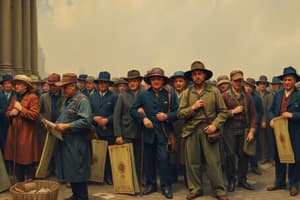Podcast
Questions and Answers
What is the Knights of Labor?
What is the Knights of Labor?
A labor union that sought to organize all workers and focused on broad social reforms.
Which organization was founded by Samuel Gompers in 1886?
Which organization was founded by Samuel Gompers in 1886?
- United Mine Workers
- Knights of Labor
- Teamsters Union
- American Federation of Labor (correct)
What event is known as the Great Railroad Strike?
What event is known as the Great Railroad Strike?
A strike in July 1877 by railroad workers protesting wage cuts.
What happened during the Haymarket Riot?
What happened during the Haymarket Riot?
What was the Homestead Strike?
What was the Homestead Strike?
What triggered the Pullman Strike?
What triggered the Pullman Strike?
What did the Homestead Act provide?
What did the Homestead Act provide?
What was the significance of the transcontinental railroad?
What was the significance of the transcontinental railroad?
What is the Turner Thesis?
What is the Turner Thesis?
What does the Safety Valve Theory propose?
What does the Safety Valve Theory propose?
What is 'A Century of Dishonor' about?
What is 'A Century of Dishonor' about?
What was the purpose of the Dawes Severalty Act?
What was the purpose of the Dawes Severalty Act?
What was the Ghost Dance?
What was the Ghost Dance?
What was the New Immigration?
What was the New Immigration?
What did 'How the Other Half Lives' address?
What did 'How the Other Half Lives' address?
What are Dumbbell Tenements?
What are Dumbbell Tenements?
What is a political machine?
What is a political machine?
What was Tammany Hall?
What was Tammany Hall?
What was the outcome of the election of 1896?
What was the outcome of the election of 1896?
Who was William Jennings Bryan?
Who was William Jennings Bryan?
What was the Cross of Gold Speech?
What was the Cross of Gold Speech?
Flashcards are hidden until you start studying
Study Notes
Labor Unions and Strikes
- Knights of Labor: Aimed to unite all workers and implemented broad social reforms.
- American Federation of Labor (AFL): Founded in 1886 by Samuel Gompers, focused on improved wages, hours, and conditions for skilled laborers; distanced itself from socialist and communist ideologies.
- Great Railroad Strike (1877): Sparked by wage cuts, this nationwide strike led to significant violence, especially in Pittsburgh, with federal troops intervening.
- Haymarket Riot: Occurred in Chicago, where a protest against police brutality led to a bomb explosion, intensifying anti-immigrant sentiments following media portrayals of the immigrants involved.
- Homestead Strike (1892): A violent strike against Carnegie Steel where ten workers died during clashes with militia; "scab" labor was used to break the strike.
- Pullman Strike: Resulted from wage cuts and high rents; Eugene Debs led protests which ended in his imprisonment and ultimately did not achieve any significant changes.
Migration and Territory Expansion
- Homestead Act (1862): Offered free land in the West, encouraging migration and settlement.
- Transcontinental Railroad: Completed in 1869, it connected eastern and western railroad systems, transforming transportation and commerce in the U.S.
- Turner Thesis: Proposed by historian Frederick Jackson Turner, it claimed the American frontier was pivotal in shaping democracy and served as a release valve during economic hardships.
- Safety Valve Theory: Suggested that westward expansion via the Homestead Act could alleviate unemployment pressure in Eastern urban areas due to high immigrant populations.
Native American Relations
- A Century of Dishonor: Written by Helen Hunt Jackson in 1881, this book exposed injustices suffered by Native Americans.
- Dawes Severalty Act: Intended to assimilate Native Americans by dissolving tribal structures and redistributing land individually.
- Ghost Dance: A ceremonial dance by the Sioux aimed at restoring the buffalo and reclaiming ancestral lands.
Immigration Trends and Urban Life
- New Immigration: Between 1865-1910, about 25 million immigrants from Southern and Eastern Europe arrived, facing cultural and language barriers that led to widespread mistrust.
- How the Other Half Lives: Jacob A. Riis's 1890 work that highlighted slum conditions in New York, influencing public opinion and policy, including figures such as Theodore Roosevelt.
- Dumbbell Tenements: Inexpensive, overcrowded housing shaped during the industrial boom; their design featured a dumbbell outline with shared corridors.
Political Landscape
- Political Machine: Organizations that secured voter loyalty through tangible rewards and maintained significant control over member activities.
- Tammany Hall: A powerful political machine in New York City during the late 1800s to early 1900s, associated with corrupt practices and local political control.
- Election of 1896: Marked by the victory of Republican William McKinley over William Jennings Bryan; saw a revival of the Republican Party's prominence through strategies promoting the gold standard and economic growth.
- William Jennings Bryan: Democratic candidate who advocated for "free silver," gaining the support of the Populist Party due to his economic reform ideas.
- Cross of Gold Speech: Bryan's famous speech at the 1896 Democratic Convention that passionately argued against the gold standard, advocating for bimetallism to support the economy.
Studying That Suits You
Use AI to generate personalized quizzes and flashcards to suit your learning preferences.




